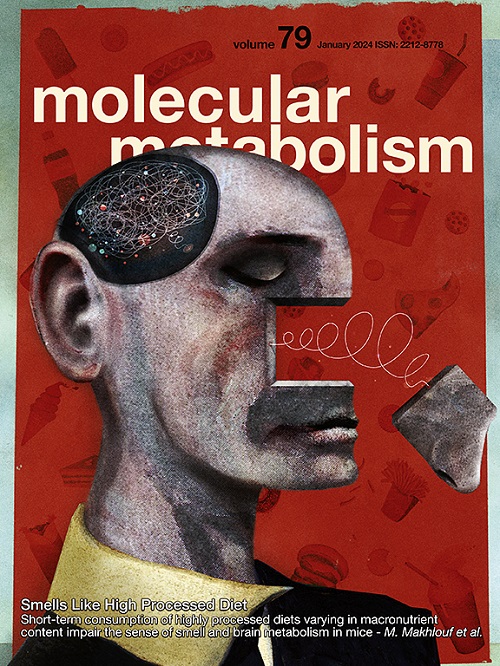Three-dimensional network of creatine metabolism: From intracellular energy shuttle to systemic metabolic regulatory switch
IF 6.6
2区 医学
Q1 ENDOCRINOLOGY & METABOLISM
引用次数: 0
Abstract
Background
Creatine serves as an intracellular shuttle for high-energy phosphate bonds, enabling rapid ATP transfer from energy-producing to energy-consuming cellular compartments. In skeletal muscle, creatine coordinates energy distribution among mitochondrial oxidative phosphorylation, glycolysis, and the phosphagen system. Consequently, creatine supplementation acutely enhances muscular performance and is widely utilized as an ergogenic aid in power-based sports. Recent studies demonstrate that enhanced creatine metabolism in adipose tissue promotes brown adipocyte renewal and boosts energy expenditure in cold environments or sedentary conditions, thereby improving overall systemic metabolism. Beyond its traditional role as an exercise supplement, the creatine metabolic network has emerged as a promising therapeutic target for metabolic disorders.
Scope of review
This review begins by revisiting the history and latest advancements in creatine research, and ultimately proposes three dimensions for the current explanation of creatine metabolism: (1) subcellular energy transport; (2) muscle-fat metabolic axis; (3) systemic energy sensing and metabolic reprogramming.
Major conclusions
The creatine cycle enables directed energy flow through mitochondrial supercomplexes (VDAC/ANT-CK) and resets systemic metabolism via subcellular energy tunnels and inter-organ interactions. Creatine kinase (CK) condensates, through liquid–liquid phase separation, can rapidly meet energy demands during exercise. Therefore, targeting the dynamics of the CK phase may be promising for enhancing athletic performance and improving metabolic diseases.
肌酸代谢的三维网络:从细胞内能量穿梭到全身代谢调节开关。
背景:肌酸作为细胞内高能磷酸键的穿梭体,使ATP从产生能量的细胞室快速转移到消耗能量的细胞室。在骨骼肌中,肌酸协调线粒体氧化磷酸化、糖酵解和磷酸化系统之间的能量分配。因此,补充肌酸能显著增强肌肉表现,并被广泛应用于力量运动中。最近的研究表明,脂肪组织中肌酸代谢的增强促进了棕色脂肪细胞的更新,并在寒冷环境或久坐不动的条件下增加了能量消耗,从而改善了整体的全身代谢。除了作为运动补充剂的传统作用外,肌酸代谢网络已成为代谢紊乱的有希望的治疗靶点。本文首先回顾了肌酸研究的历史和最新进展,最后提出了目前对肌酸代谢的三个维度的解释:(1)亚细胞能量运输;(2)肌脂代谢轴;(3)系统能量感知和代谢重编程。主要结论:肌酸循环通过线粒体超复合体(VDAC/ANT-CK)实现定向能量流动,并通过亚细胞能量通道和器官间相互作用重置全身代谢。肌酸激酶(CK)凝聚物通过液-液相分离,能快速满足运动时的能量需求。因此,针对CK期的动态可能有望提高运动成绩和改善代谢性疾病。
本文章由计算机程序翻译,如有差异,请以英文原文为准。
求助全文
约1分钟内获得全文
求助全文
来源期刊

Molecular Metabolism
ENDOCRINOLOGY & METABOLISM-
CiteScore
14.50
自引率
2.50%
发文量
219
审稿时长
43 days
期刊介绍:
Molecular Metabolism is a leading journal dedicated to sharing groundbreaking discoveries in the field of energy homeostasis and the underlying factors of metabolic disorders. These disorders include obesity, diabetes, cardiovascular disease, and cancer. Our journal focuses on publishing research driven by hypotheses and conducted to the highest standards, aiming to provide a mechanistic understanding of energy homeostasis-related behavior, physiology, and dysfunction.
We promote interdisciplinary science, covering a broad range of approaches from molecules to humans throughout the lifespan. Our goal is to contribute to transformative research in metabolism, which has the potential to revolutionize the field. By enabling progress in the prognosis, prevention, and ultimately the cure of metabolic disorders and their long-term complications, our journal seeks to better the future of health and well-being.
 求助内容:
求助内容: 应助结果提醒方式:
应助结果提醒方式:


